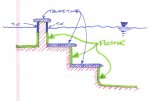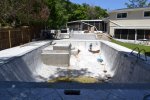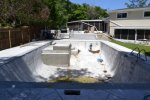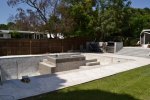During a major pool remodel I've added some interior and exterior features:
View attachment 45007
My question relates to travertine pavers (1.25" thick). I know they would be bad news along the waterline, for which I plan to use regular pool tile. I would however like to use travertine along the steps within the pool, where the stone would be continuously underwater. The interior pool steps, the exterior steps, and the coping would all be the same travertine rounded-edge 1,25" thick coping... which I think would be a very cool look.

After installing them, I would grout all the little holes and pock marks in the travertine surface using non-sanded grout.
Also wondering:
1) if I would need to bed these in pool plaster / marcite type material, of if they could be bedded with simple flex bond thinset.
2) anything stoppping me from doing the whole horizontal surface of the raised sun deck in travertine?
Thanks in advance for your thoughts and advice!
Here is another angle on that pool:

View attachment 45007
My question relates to travertine pavers (1.25" thick). I know they would be bad news along the waterline, for which I plan to use regular pool tile. I would however like to use travertine along the steps within the pool, where the stone would be continuously underwater. The interior pool steps, the exterior steps, and the coping would all be the same travertine rounded-edge 1,25" thick coping... which I think would be a very cool look.

After installing them, I would grout all the little holes and pock marks in the travertine surface using non-sanded grout.
Also wondering:
1) if I would need to bed these in pool plaster / marcite type material, of if they could be bedded with simple flex bond thinset.
2) anything stoppping me from doing the whole horizontal surface of the raised sun deck in travertine?
Thanks in advance for your thoughts and advice!
Here is another angle on that pool:





